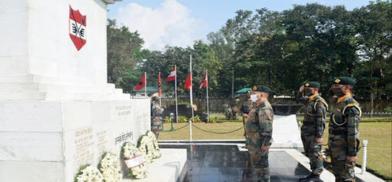Indian Army celebrates Cho La Day to commemorate 1967 action against PLA
The Indian Army on Thursday celebrated Cho La Day to commemorate the bravery of Indian troops who gave a bloody nose to the Chinese People's Liberation Army troops during clashes at the Cho La pass in 1967

The Indian Army on Thursday celebrated Cho La Day to commemorate the bravery of Indian troops who gave a bloody nose to the Chinese People's Liberation Army troops during clashes at the Cho La pass in 1967. It was the last time that a skirmish between the soldiers of the two armies turned violent in a major scale, resulting in the death of 200 Indian and 300 PLA troops.
More than 50 years since that incident, the clash in Galwan Valley in Eastren Ladakh on June 15, 2020, which resulted in the killing of 20 Indian soldiers and unverified number of PLA troops, again came as a grim reminder that skirmishes which start with fistfights and stone pelting can degrade into bloody clashes.
The incident at Cho La was preceded by heavy fighting between the Indian and Chinese armies between September 11 and September 14, 1967, over the construction of an iron fence by India in the Nathu La sector in Sikkim border to prevent Chinese incursions.
The Black Cat Division at the time was headed by Lt Gen Sagat Singh, who later became the hero of the 1971 war with Pakistan that liberated Bangladesh.
China had been encouraged to press home its perceived advantage over India after the 1962 conflict and the Indo-Pak war of 1965. It felt that India was on the backfoot and could be bullied into ceding more of its territory, a fatal mistake also made by Pakistan when it initiated a war against India in 1965 based on similar false assumptions.
China challenged Indian troops after a few incidents that occurred just before the clashes. Two Indian diplomats at the Indian Embassy in Beijing had been indicted by the Communist government on false charges of spying, which was rejected by India.
When the two diplomats returned to India, they were given a hero's welcome and people, especially in New Delhi, damaged the properties of the Chinese Embassy in India, to the extent of bringing down the Chinese flag and tearing it apart.
Also, during the course of the Indo-Pak war of 1965, PLA troops, as is their wont, had transgressed into India and killed three armed personnel in the vicinity of Tsaskur on September 19, 1965.
China also attempted to take over Nathu La in 1965 but Lt Gen Sagat Singh rebuffed their attempts.
All these episodes, coupled with the aggressive and revisionist attitude of the CPC government in China against India, had led to a situation where India was always termed as the aggressor despite all incidents and transgressions being initiated by the Chinese side.
The Indian Army sustained heavy casualties on September 11, 1967 due to the openness of the terrain and the suddenness of the assault which came in the form of murderous MMG fire by the Chinese.
However, between September 12 and September 14, India gained ascendancy over the Chinese using precise but deadly artillery fire and hand to hand combats in selected places.
On October 1, 1967, the Chinese attempted to intrude into the Sikkim side of the China-India border but due to the bravery of the Indian troops and their accurate firing, were forced to withdraw up to 3 km beyond Cho La after sustaining significant casualties.
(IANS)








Post a Comment